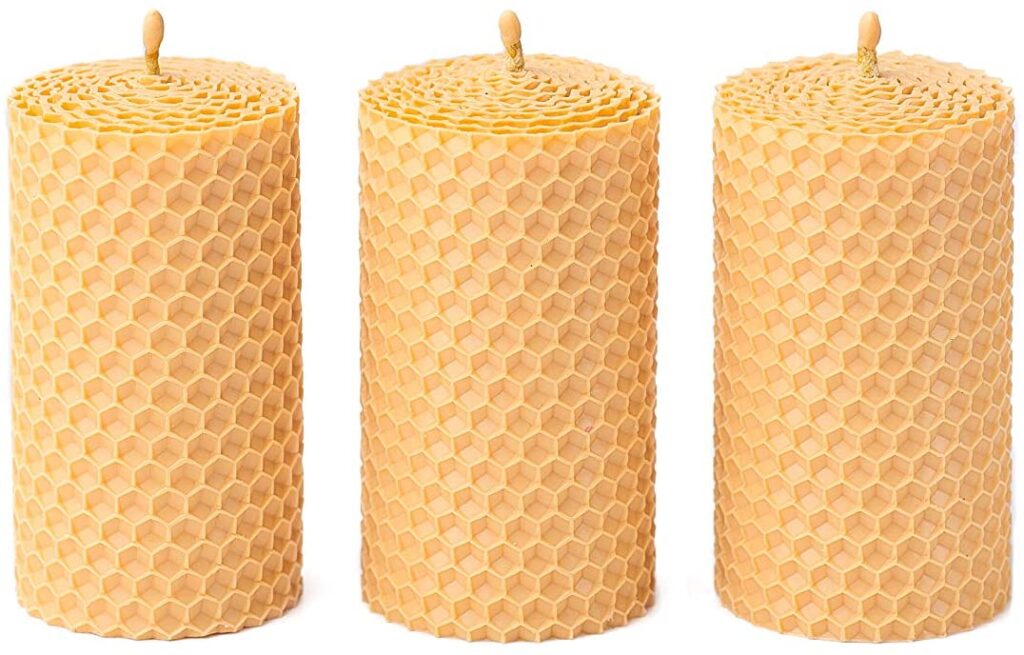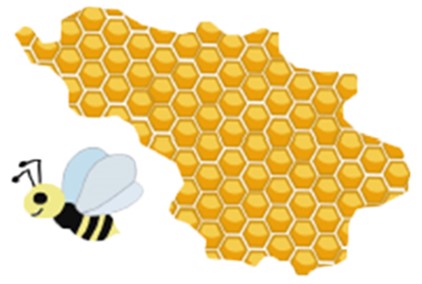Beeswax

Beeswax: The three essential facts
Beeswax is an excretion produced by worker bees that is used to build comb where they store food and raise brood. Beeswax is excreted.
Young worker bees, approximately 10 days old, are charged with the task of making beeswax for the colony. Honey bee workers have four pairs of special wax-secreting glands on the undersides of their abdomens. From these glands, they secrete liquified wax, which hardens into thin scales when exposed to the air. As the worker bee ages, these glands atrophy and the task of making wax is left to younger bees.
During its peak wax production phase, a healthy worker bee can produce about eight scales of wax in a 12 hour period. The bee colony requires about 1,000 wax scales to make a single gram of beeswax for their comb. The geometry of the honeycomb allows the bee colony to maximize their storage space while minimizing the quantity of wax needed to build the structure.
What are the uses of beeswax ?
Beeswax is used in many different applications. In the area medicial, it is used for high cholesterol, pain, fungal skin infections, and other conditions. But there is no scientific research to support these uses. In foods and beverages, white beeswax and beeswax absolute (yellow beeswax treated with alcohol) are used as stiffening agents. In manufacturing, yellow and white beeswax are used as thickeners, emulsifiers, and as stiffening agents. In the cosmetics industry, Beeswax absolute is used as a fragrance in soaps and perfumes. White beeswax and beeswax absolute are also used to polish pills.
Additional uses with Insufficient Evidence:
• Small tears in the lining of the anus (anal fissures). Early research shows that applying a mixture of beeswax, honey, and olive oil to the affected area for 12 hours reduces pain, bleeding, and itching due to anal fissures.
• Burns. Early research shows that applying a gauze with a mixture of beeswax, olive oil, and alkanna to second-degree burns speeds up healing and shortens the time spent in the hospital. Other early research shows that using a particular beeswax cream can decrease itching that occurs when a burn is healing.
• Diaper rash. Early research shows that applying a mixture of beeswax, honey, and olive oil to the affected area four times daily for 7 days reduces symptoms of diaper rash.
• Hemorrhoids. Early research shows that applying a mixture of beeswax, honey, and olive oil to the affected area for 12 hours reduces pain, bleeding, and itching due to hemorrhoids.
• Swelling (inflammation) and sores inside the mouth (oral mucositis). Early research shows that applying a mixture of honey, olive oil-propolis extract, and beeswax to mouth sores caused by cancer treatment helps speed up recovery time in people with severe ulcers. But it may not work as well in people with moderate ulcers. Also, applying honey by itself may work better than the beeswax mixture.
• Ringworm (Tinea corporis). Early research shows that applying a mixture of beeswax, honey, and olive oil to the affected area three times daily for 4 weeks improves ringworm.
• Jock itch (tinea cruris). Early research shows that applying a mixture of beeswax, honey, and olive oil to the affected area three times daily for 4 weeks improves jock itch.
• A common fungal infection of the skin (Tinea versicolor). Early research shows that applying a mixture of beeswax, honey, and olive oil to the affected area three times daily for 4 weeks improves a fungal skin infection called tinea versicolor.
• Diarrhea.
• Hiccups.
• High levels of cholesterol or other fats (lipids) in the blood (hyperlipidemia).
• Pain.
• Stomach ulcers.
See: WebMD: BEESWAX
Beeswax: Uses, Side Effects, Interactions, Dosage, and Warning (webmd.com)
Characteristics of Beeswax
• Melting Point: 142-151 deg F (61-66 deg C)
o From cappings: 146.7 deg F (63.7 deg. C)
o Paraffin melts at 90-150 deg F (32-66 deg C)
• Solidification point (liquid becomes solid): 140-146 deg F (60-63.5 deg C)
• Flash Point (wax vapor ignites): 490-525 deg F (254-274 deg C) depending upon purity
• Temperature of plasticity: 89.6 deg F (32 deg C)
• Relative density at 68 deg F (20 deg C) 0.963 (water is 1.0, so it floats)
• Saponification value: 95.35. (turn (fat or oil) into soap by reaction with an alkali)
• Acid value: 16.8-24.0
• Ester value: 66-80 (Ratio of ester to acid 3:4.3)
• Refractive index (light bending property) at 176 deg F (80 deg C): 1.4402
• Electrical resistivity: 5-20 X1012 ohm m
• Shrinkage: if melted to 200 deg F (93.3 deg C) shrinks 10 percent (by volume) when cooled to room temperature
• Solubility: insoluble in water, slightly soluble in cold alcohol, soluble in benzene, ether, chloroform, and fixed or volatile oils. Beeswax is stable for thousands of years.
(The Beekeeper’s Handbook: Fourth Edition, Diana Sammataro and Alphose Avitabile, pg 180)
Beeswax Components
Formula: C15H51 COOC30H61
| Component | Percentage of total |
|---|---|
| Monoesters | 30-35 |
| Diesters | 14-Oct |
| Hydrocarbons | 10.5-14 |
| Free acids | 12-Aug |
| Hydroxy Polyesters | 5-Apr |
| Triesters | 3 |
| Acid polyesters | 2 |
| Acid esters | <1 |
| Free acids | 12 |
| Free alcohols | <1 |
| Unidentified | 6 |
Melting wax
Using a double boiler or equal design.
Line the bottom of the large stock pot with water. Depending on which type of bowl you’re nesting inside the larger pot, you may need more or less water. Fill the bottom of your stock pot with enough tap water so that it’s at least 2 to 3 in (5.1 to 7.6 cm) deep.
• If you’re floating a small saucepan inside the larger pot, fill the stock pot so it’s about ¾ full.
• If you’re using a metal bowl that rests on the lip of the stock pot, stick with about 2 to 3 in (5.1 to 7.6 cm) of water.
• For a purpose-built double boiler, check the user manual for instructions on how much water to use.
Heat the water on the stove until it boils. Set the large stock pot filled with water on a stovetop burner and adjust the heat to “high.” Keep it there and wait for it to reach a rolling boil.
• Make sure your stock pot sits sturdily on the burner. Hot wax is dangerous, so you’ll want to prevent it from accidentally getting knocked over.
• Since water boils at 212 °F (100 °C), using a double boiler will make it difficult for the wax to exceed this temperature and reach its flash point.
• Additional methods can be viewed at: 3 Ways to Melt Beeswax – wikiHow
Important information when melting:
• Avoid extended exposure to high heat over 185 deg F (85 deg C)
• Never use an open flame: use a double boiler over electric heat
• Use only aluminum, nickel, tin, or stainless-steel containers to melt wax, as other metals will discolor it.
• Never use direct steam to melt wax, as it permanently changes the composition of the wax.
• Separate dark, old wax from light, new wax and never add propolis to wax.
• Don’t melt plastic frames in the wax melter, they can warp.
• Never store pesticides near beeswax or combs because such chemicals are lipophilic and will bind with wax. This includes miticide strips.
(The Beekeeper’s Handbook: Fourth Edition, Diana Sammataro and Alphose Avitabile, pg 180)
Interesting facts about Beeswax
• Bees need to eat between 7 and 9 pounds of honey to produce 1 pound of beeswax.
• 1 pound of beeswax will make 35,000 wax cells.
• 1 pound of beeswax stores 22 pounds of honey.
• There are 5000,000 wax scales per pound (one scale measures 1/8 inch (3.175 mm) in diameter)
• Under optimal conditions, 10,000 bees produce one pound of beeswax in three days.
• Wax cappings yield 90-97 percent beeswax, depending on the extraction method. These number reflect conventional, not commercial, methods.
• Culled comb yield 37 to 83 percent wax. Brood combs yield 15-16 percent wax.
(The Beekeeper’s Handbook: Fourth Edition, Diana Sammataro and Alphose Avitabile, pg 181)
